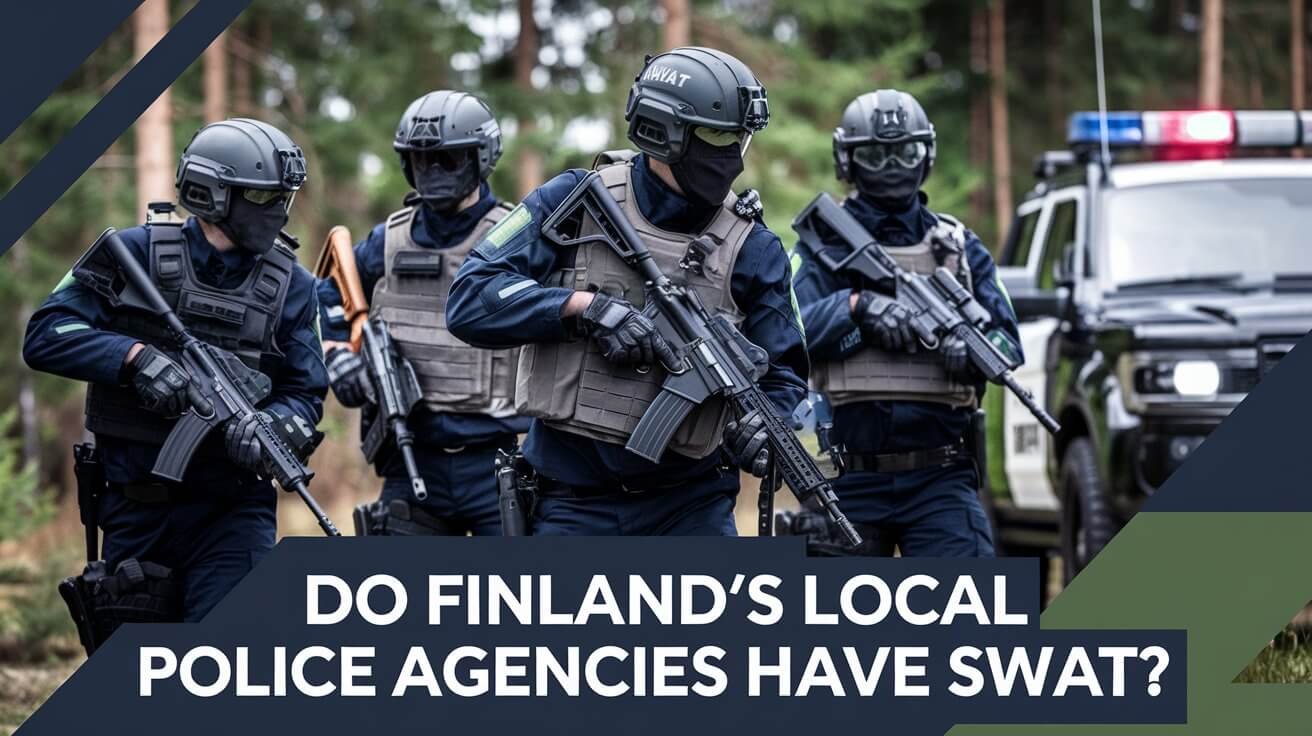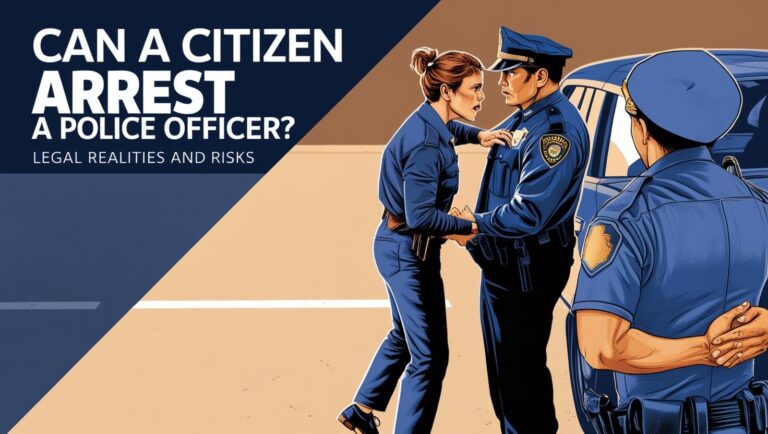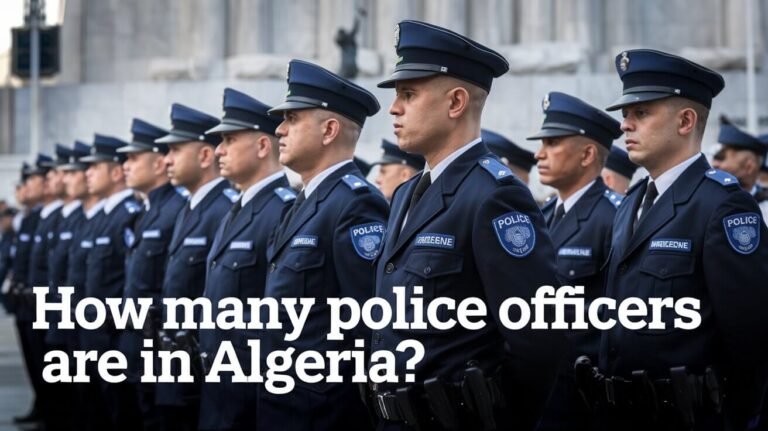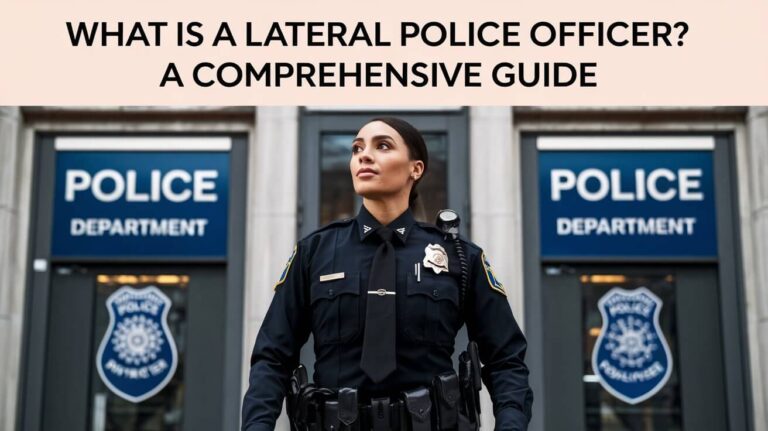Do Finland’s Local Police Agencies Have Swat: Units in 2025

Finland’s police focus on building trust with the community. They use de-escalation techniques instead of the US SWAT team model. Finland doesn’t have SWAT teams in every town. Instead, they have national and regional units for high-risk operations.
This method helps keep crime rates low and earns the public’s trust. The Police of Finland works with other agencies to keep everyone safe. They have specialized units for dangerous situations, unlike traditional SWAT teams.
Finnish Police Special Response Units Structure
Finland’s police special response units are ready for critical incidents. Their structure helps local police agencies. It includes the Karhu unit, regional teams, and a command team.
These units get tough training for high-risk situations. The Karhu unit, or “Bear Squad,” helps local police in big incidents. Regional teams handle incidents in their areas. They work with the command team for smooth deployment.
Components of the Finnish Police Special Response Units
- Karhu unit: a national-level team that provides support to local police agencies in high-risk situations
- Regional response teams: responsible for responding to incidents within their respective areas
- Command structure: oversees the deployment of specialized units and ensures effective coordination
The Finnish police special units help local police in critical times. Their setup lets them act fast and well in emergencies. They’re ready for anything from hostage situations to terrorism.
| Unit | Responsibility |
|---|---|
| Karhu unit | Provides support to local police agencies in high-risk situations |
| Regional response teams | Respond to incidents within their respective areas |
| Command structure | Oversees the deployment of specialized units and ensures effective coordination |
Historical Development of Finnish Tactical Units
Finland’s law enforcement has grown over time, influenced by its history and culture. The need for specialized units to handle high-risk situations has shaped the development of Finnish tactical units. This evolution is part of Finland’s law enforcement history, adapting to new threats.
Finland focuses on community policing and de-escalation. This approach has made tactical units a key part of law enforcement. The history of Finnish law enforcement highlights the importance of teamwork between police and emergency services.
Some key milestones in the development of Finnish tactical units include:
- Establishment of specialized units to respond to high-risk situations
- Development of training programs for tactical unit officers
- Introduction of new technologies and equipment to support tactical operations
In recent years, Finland has made big strides in tactical units. The police have invested in units trained for counter-terrorism and hostage rescue. This shows Finland’s dedication to public safety and security. The growth of tactical units is a key part of maintaining order and safety.
| Year | Event | Description |
|---|---|---|
| 1990s | Establishment of specialized units | Finland’s police agencies established specialized units to respond to high-risk situations |
| 2000s | Development of training programs | Training programs were developed for tactical unit officers to enhance their skills and knowledge |
| 2010s | Introduction of new technologies | New technologies and equipment were introduced to support tactical operations and enhance public safety |
Do Finland’s Local Police Agencies Have SWAT Operations?
Finland’s law enforcement focuses on keeping peace and building trust with the community. Unlike many countries, Finland doesn’t have SWAT teams. Instead, it uses specialized units for high-risk situations.
These units are trained to handle dangerous cases. They work based on the situation’s needs, making sure they’re used right. This approach helps keep everyone safe.
Finland has Critical Incident Negotiation Units and Special Operations Units. The National Police Board ensures all units are ready for tough situations. This is because Finland values peace and has less gun violence.
Operational Jurisdiction and Response Protocols
Finland’s police work is split into different areas, each with its own team. They have quick and effective plans for emergencies. Their training focuses on solving problems without violence.
They work together well, keeping everyone safe. Their plans are always being improved to stay effective.
Unit Distribution and Specialized Units
Finland’s special units are mainly in cities. They have the latest tools, like police dogs and special cars. The Special Intervention Unit Karhu in Helsinki is a top team.
It has about 60 officers and deals with big threats. They work with the Helsinki Police and the National Police Board. This team is key to Finland’s safety.
Equipment and Arsenal of Finnish Tactical Teams
Finland’s tactical teams have special gear for their unique law enforcement style. They use advanced firearms, protective gear, and communication systems. These tools help them handle dangerous situations well.
The gear in Finland’s law enforcement arsenal is chosen with care. It meets the country’s law enforcement needs. Key features include:
- Advanced firearms, such as rifles and pistols, designed for precision and accuracy
- Protective gear, including helmets and body armor, to ensure officer safety
- Communication systems, such as radios and smartphones, to facilitate real-time communication and coordination
Finland’s tactical teams also use robots and drones. These tools help them respond better. They make operations faster and safer for officers.
| Equipment | Description | Benefits |
|---|---|---|
| Robots | Used for real-time intelligence, audio transmission, and suspect location | Enhances officer safety, reduces operation times |
| Drones | Used for aerial surveillance and reconnaissance | Provides real-time video feed, enhances situational awareness |
| Extended Range Electronic Projectile (XREP) | Used as a less-lethal weapon | Reduces risk of injury to officers and suspects |
Finland’s tactical teams are ready for many high-risk situations. Their special equipment makes them safer and more efficient.
Training Standards for Finnish Special Response Officers
Finland’s special response officers get tough training for risky situations. The selection is tough, and they must meet high standards. They keep learning new skills and tech to stay sharp.
Training is key for Finland’s law enforcement to succeed. Special response officers learn to handle critical incidents well. They focus on managing stress and staying strong. Their training includes:
- Controlled breathing to handle stress in real-life situations
- Physical fitness to do their job well
- Updates on the newest law enforcement tech and methods
Finland’s focus on training makes its special response officers ready for tough times. They are a big help to the country’s law enforcement.
Deployment Scenarios and Protocols
Finland’s law enforcement teams have set up specific plans for their tactical units. These plans help them handle high-risk situations well. They make sure Finland’s law enforcement works smoothly.
The plans in Finland focus on solving problems peacefully and working with the community. This way, Finland’s tactical teams can act fast and safely in emergencies. They aim to protect everyone involved.
Some important scenarios and protocols in Finland include:
- High-risk arrests and warrant service
- Hostage rescues and barricaded suspect situations
- Counter-terrorism operations
- Public order scenarios, such as riots and demonstrations
Finland’s law enforcement also values teamwork and sharing resources. This is key for smaller agencies to tackle big challenges. By working together, Finland’s teams can keep their communities safe.
| Deployment Scenario | Protocol |
|---|---|
| High-risk arrest | Establish perimeter, use specialized equipment, and follow established communication protocols |
| Hostage rescue | Conduct thorough risk assessment, use specialized equipment, and follow established communication protocols |
| Counter-terrorism operation | Conduct thorough risk assessment, use specialized equipment, and follow established communication protocols |
Coordination with Regular Police Forces
Good law enforcement coordination is key for quick and effective responses to high-risk situations. In Finland, tactical teams team up with regular police to get the job done. They use advanced communication systems to share info and work together in real-time.
A strong chain of command is also vital for Finland’s law enforcement success. It helps make quick and effective decisions in emergency situations. This way, both tactical teams and regular police can work together well. Finland’s police can handle everything from small incidents to big crises thanks to this coordination.
Some important parts of this coordination include:
- Real-time info sharing through advanced communication systems
- Clear chain of command for swift decision-making
- Regular training and exercises to ensure seamless cooperation between tactical teams and regular police forces
Focusing on law enforcement coordination, communication systems, and chain of command, Finland’s police can keep providing effective responses. This ensures public safety and security.
International Cooperation and Standards
Finland is key in global law enforcement cooperation, following strict standards. This helps Finnish law agencies share and learn from others. It also aids in fighting crime worldwide and keeping people safe.
Finland works closely with groups like the National Bureau of Investigation (KRP) and the Finnish Security Intelligence Service (Supo). These teams share info and team up to fight global crimes. Finland’s law agencies show they’re dedicated to being professional and honest by joining these efforts.
Some examples of Finland’s law enforcement work include:
- Working with the International Criminal Investigative Training and Assistance Program (ICITAP) to train foreign police.
- Helping create global law enforcement rules, like the Basic Principles on the Use of Force and Firearms by Law Enforcement Officials (BPUFF).
- Deploying civilian police (CIVPOL) globally, focusing on helping in complex humanitarian emergencies.
Working together and following strict standards, Finland’s law agencies can tackle crime’s changing nature. They help keep people safe at home and abroad.
Response Times and Geographic Coverage
Finland’s law enforcement agencies focus on quick responses and wide coverage. They plan and work with other emergency services to handle high-risk situations well. This ensures safety across the country.
In cities, police and emergency services are quicker because of more people and buildings. But, rural areas face longer waits because of distance and fewer resources. To solve these issues, they use new technology and team up with other services.
Urban Areas
Urban areas get help faster, which is key in urgent situations. Quick response times are vital when every second matters.
Rural Regions
Rural areas need special plans for good coverage. Police and emergency teams work with local people to offer help, despite the distance and fewer resources.
| Area Type | Average Response Time | Geographic Coverage |
|---|---|---|
| Urban | 5-10 minutes | Comprehensive, with multiple emergency services |
| Rural | 15-30 minutes | Strategic, with coordination between services and local communities |
Law enforcement agencies know the differences in response times and coverage between cities and rural areas. They use this knowledge to make safety plans that work for everyone.
Public Safety Impact and Statistics
Finland’s law enforcement agencies play a big role in keeping the country safe. The country’s low crime rates show this. Finland focuses on community policing and de-escalation techniques to keep the peace.
Finland’s law enforcement has a big impact on public safety. This can be seen in several ways, including:
- Low crime rates: Finland is one of the safest countries in the world. It’s a safe place for both citizens and visitors.
- High level of public trust: People in Finland trust their law enforcement agencies a lot. This trust is key for effective community policing.
- Effective community policing: Finland’s law enforcement works hard to build strong relationships with the community. This helps prevent crime and keep everyone safe.
Finland’s way of handling law enforcement has been a success. The country’s statistics show how well this approach works. It could be a good example for other countries to follow.
| Category | Finland | Other Countries |
|---|---|---|
| Crime Rate | Low | High |
| Public Trust | High | Low |
| Community Policing | Effective | Ineffective |
Modern Challenges and Adaptations
Finland’s law enforcement agencies deal with many modern challenges. These include new threats and the need to adapt. To meet these needs, they use new technologies and adjust to changes.
Some big challenges for Finland’s law enforcement include:
- Using new tech like data analytics and social media to help their work
- Dealing with new crimes like cybercrime and organized crime
- Coming up with new ways to handle changes like more migration and cities growing
Being open to new ideas and changing with the times, Finland’s law enforcement stays on top of threats. This helps keep everyone safe and builds trust with the public.
Technology Integration
Technology is a big part of how Finland’s law enforcement adapts today. They use things like data analytics and social media to fight crime and keep people safe.
Threat Evolution
The threats facing law enforcement are always changing. Finnish agencies must keep up with new crimes and find ways to handle different situations. This includes fighting cybercrime and organized crime, and adjusting to changes in society.
Bottom Line
Finland’s law enforcement is unique and effective. It focuses on community engagement and de-escalation. The country doesn’t have traditional SWAT teams. Yet, it has a strong SWAT capabilities framework.
This framework helps them handle critical incidents well. It also keeps the public safe.
Finland’s law enforcement model is inspiring. It uses de-escalation and community policing. The country’s specialized units, like the Karhu Unit, are ready for many situations.
They deal with hostage situations and armed confrontations. They always try to save lives and reduce harm.
Finland’s approach shows how to improve public safety. It offers insights into using community-focused strategies. These strategies can build trust and make communities safer.
Post-Specific FAQs
Do Finland’s local police agencies have SWAT teams?
No, Finland’s local police don’t have SWAT teams like in the US. They use special units for high-risk jobs. These include the Karhu unit and regional teams.
What is the structure of Finnish Police Special Response Units?
Finland’s Police Special Response Units have a few teams. There’s the Karhu unit for the whole country. Also, there are regional teams and a command team that decides when to send them out.
How has the historical development of Finnish tactical units shaped their approach?
Finland’s police units have been shaped by the country’s history. They focus on community policing and avoiding violence from the start.
How do Finland’s local police agencies respond to high-risk situations without traditional SWAT teams?
Finland’s police use special units for risky situations. Their deployment is based on where they are needed most. This ensures a quick and effective response.
What kind of equipment and arsenal do Finnish tactical teams use?
Finnish tactical teams have special gear for their work. This includes advanced guns, protective gear, and communication tools.
What are the training standards for Finnish special response officers?
Becoming a special response officer in Finland is tough. Candidates must meet high standards. Once in, they keep training to stay sharp.
How are deployment scenarios and protocols structured in Finland?
Finland’s teams follow specific plans for different situations. This ensures they respond well to risks, focusing on safety and community.
How do Finnish law enforcement agencies coordinate with regular police forces?
Finnish tactical teams work closely with regular police. They use advanced systems and clear commands for a smooth response to emergencies.
How does Finland’s law enforcement participate in international cooperation and adhere to standards?
Finland joins international law enforcement efforts. They follow global standards, showing their commitment to professionalism and integrity.
How do Finnish law enforcement agencies ensure rapid response times and geographic coverage?
Finnish police aim for quick responses everywhere. They use technology and work with other services to overcome challenges in cities and countryside.
What is the public safety impact and statistics of Finland’s law enforcement approach?
Finland’s police efforts make the country safer. Low crime rates and high trust in police show their approach works well.
How are Finnish law enforcement agencies adapting to modern challenges and threats?
Finnish police are using new tech and adjusting to new crimes. They stay ahead of threats to keep everyone safe.






